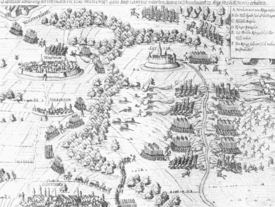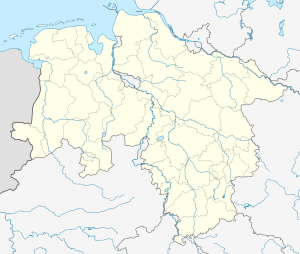Battle of Lutter
The Battle of Lutter (Lutter am Barenberge) took place during the Thirty Years' War, on 27 August 1626 (17 August 1626 in the old Julian calendar), between the forces of the Lower Saxon Circle, combining mostly Protestant states, and led by its Circle Colonel Christian IV of Denmark, and the forces of the Catholic League. Lutter am Barenberge lies to the south of the modern town of Salzgitter, then within the Imperial Circle of Lower Saxony, and now in northwest Germany.
| Battle of Lutter | |||||||
|---|---|---|---|---|---|---|---|
| Part of the Thirty Years' War | |||||||
 Battle of Lutter, contemporary woodcut | |||||||
| |||||||
| Belligerents | |||||||
|
|
| ||||||
| Commanders and leaders | |||||||
|
Christian IV Philipp of Hesse-Cassel (POW) Hans Philipp Fuchs of Bimbach † |
Count of Tilly Johann Jakob, Count of Anholt | ||||||
| Strength | |||||||
| 20,000 | 20,000 | ||||||
| Casualties and losses | |||||||
| 3,000 dead, 2,500 captured and 2,000 deserters | 700 dead or wounded | ||||||
 Lutter am Barenberge Location within Lower Saxony  Lutter am Barenberge Lutter am Barenberge (Germany) | |||||||
The battle resulted in a heavy defeat of Christian IV's troops by those of Emperor Ferdinand II, led by the Catholic League general Johan Tzerclaes, Count of Tilly.
Prelude
Before the Thirty Years' War hostilities reached the Lower Saxon Circle, the chiefs of state of its members were alarmed and prepared for the worst. So in 1625 they elected from their midst the Lutheran Duke Christian IV of Holstein, simultaneously King of Denmark, the new Lower Saxon Circle Colonel, i.e. the commander in chief of the joint circular forces. In this function Christian IV allied with Ernst von Mansfeld in a military campaign and planned to start in Thuringia in Middle Germany, and then take to its south. His intention was to bring relief to German Protestants, who had been severely defeated a few weeks earlier in the Battle of Dessau Bridge.
With the participation of Christian IV, the Thirty Years' War, which had hitherto been confined to opposing factions of the Holy Roman Empire, now extended to other European powers, though Christian, as Duke of Holstein, was not a complete foreigner.
The battle
Christian IV, in an attempt to take advantage of the absence of Albrecht von Wallenstein, set out to attack Tilly's army in late July 1626. In response, Tilly took the important Protestant fortresses at Münden, Northeim, and Göttingen to draw Christian into a battle.[2] While Christian's force encountered little resistance at first as it moved southwards, Wallenstein eventually listened to Tilly's calls for reinforcements, sending him an additional 4,300 soldiers. The Lower Saxon forces and Danes, demoralized, exhausted, and hungry, had no intention of fighting a major battle against a superior force, especially since the fortresses they planned to defend had already fallen, but torrential rain, muddy roads, and a refusal to let go of their valuable baggage hindered their retreat. By 26 August Christian had decided to make his stand between the small villages of Hahausen and Lutter am Barenberge.[3]
In the opening artillery engagement on the morning of 27 August, Christian only utilized two of his twenty-two field guns, while Tilly bombarded the Danes while the rest of his army came up. The main action opened as Count Anholt lead an assault by crossing the Hummecke stream, still wet despite the summer heat drying out nearby streams[4], and attacking the Danish left. Christian was untangling the baggage train, prompting Maurice of Hesse's son Philip to approve an unauthorized counter-attack.[lower-alpha 1] After being just barely being beaten back by the Catholic infantry, the Lower Saxons and Danes lost all organisation when they returned to their former positions, which left the Dano-Lower Saxon infantry vulnerable when Tilly ordered his center to cross the stream and capture Christian's artillery. Native regiments under Christians command were decimated and forced to surrender while allowing his second and third lines to retreat. In addition to men, Christian lost two wagons loaded with gold, Philipp of Hessen-Kassel and his elite general General Fuchs.[5] Christian, after having four horses shot out from under him, fled to Wolfenbüttel with what remained of his own cavalry.[3]
Aftermath
The battle was an irreparable blow to Christian IV, Denmark and the Lutheran states in the Lower Saxon Circle. All Lower Saxon states, except those of Mecklenburg and Holstein, refused Christian their further allegiance. Catholic forces conquered the Lutheran Prince-Archbishopric of Bremen, threatened the Calvinist city of Bremen, took the Lutheran Westphalian Prince-Bishopric of Verden. Tilly's troops however, were far too tired to deliver a knock-out blow, giving their enemies time to recuperate.[6]
Christian's defeat cut off Ernst von Mansfeld, whose army was now stranded in the Tatra mountains waiting for reinforcements from Bethlen of Transylvannia.[5] The defeat forced the Protestant German princes to sue for peace, but instead, Ferdinand II issued the Edict of Restitution which encouraged Sweden to enter the war.[7]
Further reading
- Guthrie, William P. 2002. Battles of the Thirty Years War: From White Mountain to Nordlingen, 1618 - 1635. London: Greenwood Press.
- Lee, Stephen J. 1991. The Thirty Years' War. London: Routledge.
- Parker, Geoffrey, and Simon Adams. 1997. The Thirty Years' War. London: Routledge.
- Christian IV
- Johann Tserclaes, count von Tilly
Notes
- Philipp was badly wounded in the face and taken prisoner. When Imperial soldiers were quarreling over his ransom, one of them shot him dead.[1]
References
- von Rommel, Christoph (1837). Neuere Geschichte von Hessen [Newer history of Hesse] (in German). Kassel: Friedrich Perthes. pp. 337–342.
- T. Winkelbauer, Ständefreiheit und Fürstenmacht (2 vols., Vienna, 1982), pp.74-78, 207-13; H.W. Bergerhausen, 'Die "Verneuerte Landesordnung" in Böhmen 1627', HZ, 272 (2001), 327-51
- Lockhart, Paul Douglas. 1996. Denmark in the Thirty Years' War, 1618-1648: King Christian IV and the decline of the Oldenburg State. Selinsgrove: Susquehanna University Press.
- Gindley, Thirty Years War, I, pp.273-8
- Wilson, Peter H. (2009-07-30). Europe's Tragedy: A New History of the Thirty Years War. Penguin UK. ISBN 9780141937809.
- Polišenský, Thirty Years War, p.144
- Guthrie, William P. 2001. Battles of the Thirty Years' War: from White Mountain to Nordlingen, 1618-1635. Westport, CT: Greenwood Press.